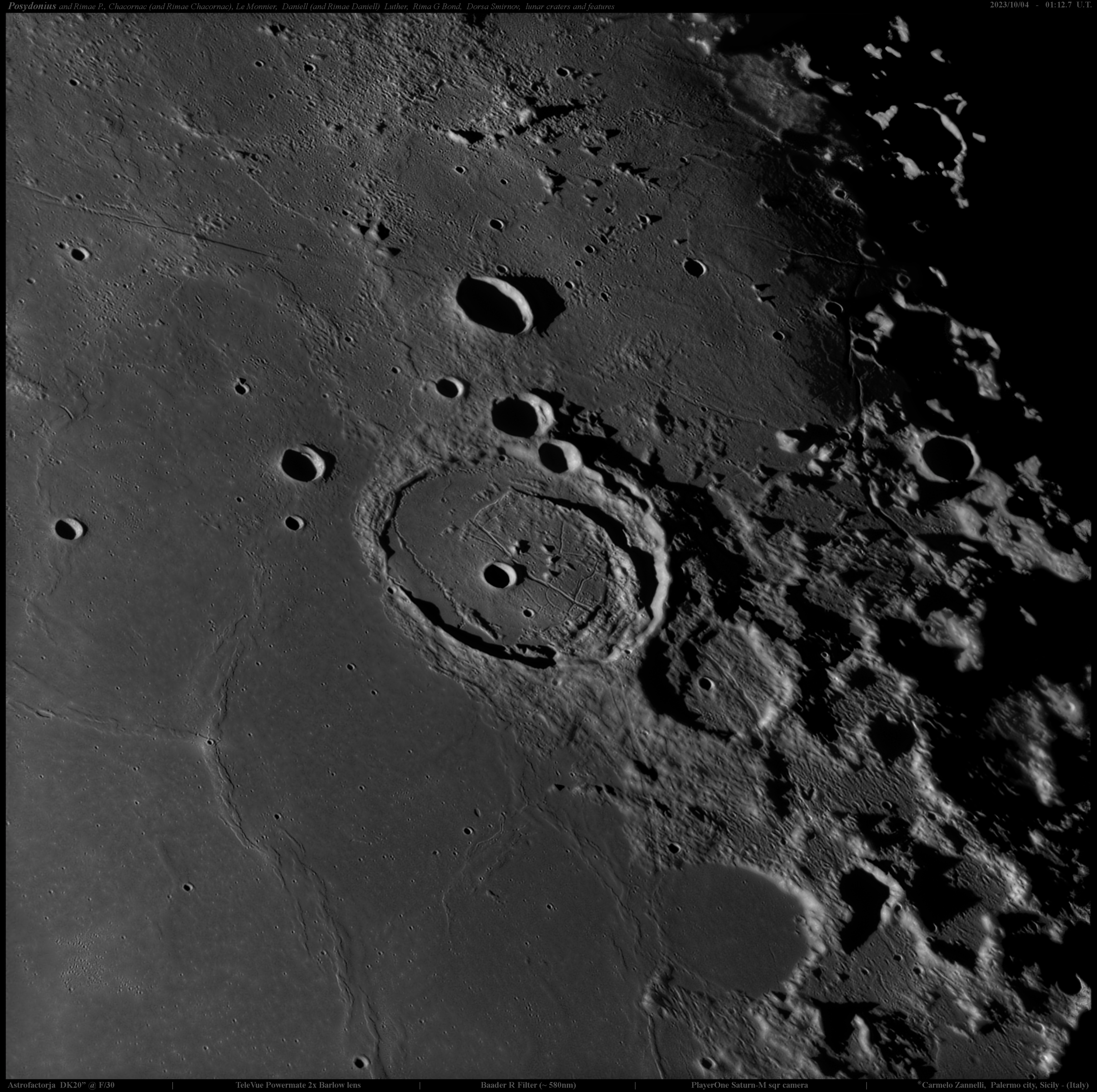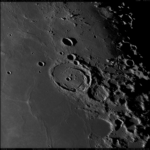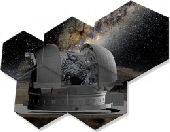[3D-Model by Marco Campaniello]
Thanks so much to my friend Marco Campaniello for 3D-Model computation of the image
Italiano:
Ecco il magnifico cratere lunare “Posidonius“, ripreso attraverso il mio telescopio da 20” (51cm.) in configurazione Dall-Kirkham, nella notte tra il 03 ed il 04 ottobre 2023 scorso, in discrete condizioni di seeing (stimato in 6,5/10 della scala Pickering) ed in fase lunare calante.
Come già scritto in un’altra mia precedente presentazione di questo cratere (v. al link: Carmelo Zannelli – astrophotographer » Posydonius crater), si tratta di un cratere da impatto (del periodo Imbriano Superiore) del diametro di circa 95 km e profondità circa 2.3 km, locato alla estremità nord-est del Mare Serenitatis, a sud della distesa di lava denominata “Lacus Somniorum”.
Il bordo di Posidonius è profondo e oscurato, soprattutto sul bordo occidentale, e l’interno del cratere è stato ricoperto da un flusso di lava in tempi molto antichi. I bastioni del cratere possono comunque ancora essere osservati soprattutto a sud e ad est del bordo del cratere e, in misura minore, a nord.
Non esiste alcun picco centrale dovuto all’impatto, ma il fondo del cratere è collinoso e allacciato con un sistema a rille (canali) chiamato Rimae Posidonius. Il fondo è anche leggermente gonfio a causa del precedente sollevamento di lava, che probabilmente ha anche prodotto il complesso di rilles o rimae.
All’interno di esso, si trova un bordo più piccolo e semicircolare (parziale) di un cratere concentrico ricoperto di lava, sfalsato verso il bordo orientale.
Possono anche essere osservati, in questa immagine, altri crateri come il piccolo cratere “Luther” (visibile, un pò isolato, in alto a sinistra con un diam. di 10km), al centro e in alto il cratere “Daniell” con la sua Rima Daniell, il cratere eroso e quasi totalmente sommerso “Hall”, il cratere “G Bond” di 32km di diametro (alla destra di Posydonius) che da il nome alla lunghissima e profonda “Rima G Bond” (in questa immagine parzialmente in ombra, sul lato non più illuminato della Luna, poiché in fase calante).
Infine l’antichissimo cratere “Chacornac”, di 53 Km. di diametro, formatosi nel periodo Pre-Imbriano (in media circa 4 miliardi di anni fa), attraversato dalle Rimae Chacornac dal quale prendono nome.
Grazie, come sempre, per la Vostra cortese attenzione e…. ad maiora, semper!
Dettagli Tecnici:
Telescopio Astrofaktorja DK20″ @ ~ F/30 – Player One Saturn M SQR camera – TeleVue Powermate Barlow 2x – Baader R filter (~580nm) – Seeing ~ 6,5/10 in R band – sito: Palermo city @ my personal Observatory.
**************************************************************************************************************************************************
English:
Here is the magnificent lunar crater “Posidonius“, imaged by my Dall-Kirkahm 20” telescope in my astronomical observatory, taken on the night between 03 and 04 October 2023, in fair seeing conditions and in a waning moon phase.
As already written in another previous presentation of mine of this crater (see @ link: Carmelo Zannelli – astrophotographer » Posydonius crater), it is an impact crater (from the Upper Imbrian period) with a diameter of approximately 95 km and a depth of approximately 2.3 km, located at the north-east end of the Mare Serenitatis, south of the expanse of lava called “Lacus Somniorum”.
The rim of Posidonius is deep and darkened, especially on the western edge, and the interior of the crater was covered by a lava flow in very ancient times. The crater ramparts can however still be observed mainly to the south and east of the crater rim and, to a lesser extent, to the north. There is no central peak due to the impact, but the crater floor is hilly and laced with a system a rille (canals) called Rimae Posidonius. The bottom is also slightly swollen due to previous lava uplift, which probably also produced the rilles or rimae complex. Inside it, lies a smaller, semicircular (partial) rim of a concentric crater covered in lava , offset towards the eastern edge.
Other craters can also be observed in this image such as the small “Luther” crater (visible, somewhat isolated, top left with a diameter of 10km), in the center and at the top of the image there’s the “Daniell” crater with its Rima Daniell, the eroded and almost totally submerged “Hall” crater, the “G Bond” crater of 32km in diameter (to the right of Posydonius) which gives its name to the very long and deep “Rima G Bond” (in this image partially in shadow, on the no longer illuminated side of the Moon, as it is in its waning phase).
Finally, the very ancient “Chacornac” crater, 53 km in diameter, formed in the Pre-Imbrian period (on average about 4 billion years ago), crossed by the Rimae Chacornac from which they take their name.
Thank you, as always, for your kind attention and…. ad maiora, semper!
Technical Details:
Astrofaktorja DK20″ telescope @ ~ F/30 – Player One Saturn M SQR camera – TeleVue Powermate Barlow 2x – Baader R filter (~580nm) – Seeing ~ 6.5 /10 (max.) in R band – site: Palermo city @ my personal Observatory.


